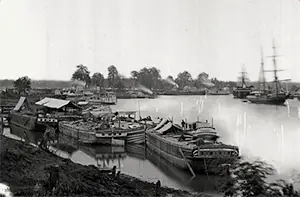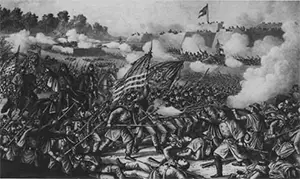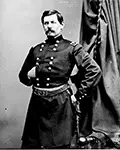The Battle of the Seven Days
The Battle of the Seven Days was a serious of battles between the Army of the Potomac and the Army of Northern Virginia in the early days of the American Civil War. The two armies fought six times during a period of a week in June 1861; after many deaths and no clear victory, the Union army retreated from its offensive against the Confederate capital, Richmond.
A frustrated Lincoln on Jan. 27, 1862, issued Special Orders No. 1, which set a deadline of February 22 for a coordinated land and sea attack on Confederate positions. The goal was for McClellan's army to attack the forces under the command of Gen. Joseph Johnston (right) at Centreville and Manassas. McClellan responded with a rather unwieldy proposition that came to be known as the Peninsula Campaign. 
McClellan's plan was for his troops to sail down the Potomac River and then up the Rappahannock River, with the idea to hit Johnston's forces as designated and then, eventually, march on to Richmond. Lincoln was not in favor of this plan because it left Washington, D.C., exposed. Also, as much as Lincoln wanted Richmond captured, he more wanted the Confederate armies engaged and defeated. Johnston, meanwhile, somehow got wind of what McClellan was proposing to do and withdrew his troops from Manassas. McClellan revised his plan to include troop movements down the Chesapeake Bay to Fort Monroe and then on land up the peninsula between the James River and the York River; Lincoln approved the revision. 
The Army of the Potomac at that time totaled about 130,000 soldiers, 15,000 horses, more than 1,000 wagons, and a few dozen artillery batteries. McClellan successfully transported all of those men all of that materiel to Fort Monroe–rather quickly, in fact. Once the troops were back on land, progress slowed. Confederate troops under John B. Magruder were waiting at Yorktown. McClellan, despite outnumbering Magruder's force 4–1, ordered his men to construct siege works. Johnston moved his force in, to even the numbers a bit, but, with the exception of some heavy fighting at Williamsburg, neither side launched more than a small skirmish for more than a month. Johnston then left again, with McClellan in pursuit. Meanwhile, the U.S. Navy sent an expedition up the James River to reach Richmond; the Confederate defenders were ready for that maneuver and turned back the attack at Drewry's Bluff. The Army of the Potomac crossed the Chickahominy River and was within striking distance of Richmond. McClellan again stopped and waited for reinforcements, despite his force being far the superior in numbers. Johnston's troops attacked on May 31, near the village of Seven Pines (also called Fair Oaks) and were repulsed. Johnston was wounded in the battle, and replacing him at the head of the Army of Northern Virginia was Robert E. Lee. 
Again, McClellan delayed, still focused on Richmond but wanting to get his big guns close to the city. Lee called the troops under Stonewall Jackson in the Shenandoah Valley to form a support action and also sent J.E.B. Stuart's cavalry force to circumnavigate the Army of the Potomac, in order to gauge its size and capability. Lee had also directed his men to erect extensive defensive fortifications around Richmond. The armies eventually came to blows, in the Seven Days Battles, a series of six battles from June 25 to July 1. Lee was much more of an aggressive commander than Johnston was and saw an opportunity to attack the cautious McClellan. As well, Lee knew that his forces wouldn't approach the numbers of the Army of the Potomac and that, if McClellan ever did reach Richmond, he stood a good chance of taking it. Lee decided that, once Jackson and his troops arrive, the South would go on the offensive. McClellan took the initiative on June 25 in the swamps around the town of Oak Grove, hammering away at Lee's defenses without success. Lee, even though Jackson had not yet arrived, returned the favor the following day, hitting Union positions along Beaver Dam Creek, without much success; both sides fell back at the end of the day. This was also known as the Battle of Mechanicsville. The action on June 27 was on the south side of the Chickahominy, at the Battle of Gaines' Mill. Fitz John Porter's men came under particularly heavy Confederate fire and lost two dozen cannon but, at the end of the day, had held their positions long enough for the rest of the Union force to escape the battlefield. John B. Hood's division had made the first break in the line, but the fighting had started so late in the day (mid-afternoon) that darkness saved the Union in the end. Lee claimed the battlefield and the victory, but McClellan still had his army largely intact. McClellan, despite knowing that reinforcements were on the way, changed tactics and returned to his supply line, withdrawing to Harrison's Landing. The following day was rather uneventful, and a Confederate attack on the Union rear guard at Savage's Station on June 29 came to naught. At Glendale/Frayser's Farm on June 30, Confederate troops launched a large attack and captured one Union division commander, George McCall and another dozen Union cannon. Some of the fighting was particularly intense, involving hand-to-hand combat with bayonets and clubbed rifles. That was the only Confederate advance. (This battle is also known by several other names, including Nelson's Farm and White Oak Swamp.) All of that fighting convinced the ever cautious McClellan to assume a strong defensive position on Malvern Hill, north of the James River. On July 1, Lee ordered attack after attack, losing 5,600 men but failing to dislodge McClellan's force. When the fighting stopped, the positions of the army were relatively similar to what they had been at the start of the day. However, the dispositions of the two commanders had changed. Lee was quite ready to continue the attack. McClellan pulled back to Harrison's Landing and was then recalled to Washington, D.C., ending the Peninsula Campaign. The Seven Days Battles were a series of confrontations not unlike those that would come later in the war. They were brief, sometimes very bloody, and gained very little in the way of ground for either side. Heavy rains sapped morale and made marching, firing a rifle, and even setting up camp difficult. Some of the battles featured divisions quite far geographically from each other, requiring intricate communication networks in order to coordinate battle plans. With some exceptions, both this communication and the overall of the commanders' battle plans was poor. One thing did stand out to many Union soldiers: the willingness of Confederate soldiers to sustain frontal assaults in the face of withering enemy fire. |
|
Social Studies for Kids
copyright 2002–2024
David White



 Gen.
Gen. 
